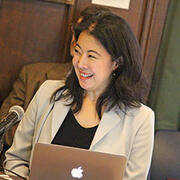
On a recent autumn afternoon in a packed Braun Room on the HDS campus, Anna Sun, a 2018–19 research associate in the Women’s Studies in Religion Program at HDS, spoke about her research project this year, titled, “Women in Prayer: Gendered Religious Life in Contemporary Urban China.”
During her early October lecture to members of the HDS and Harvard community, Sun explained that, “Confucianism was put into context by Jesuit missionaries in the sixteenth century. In this instance of encounter, it became a religion. It was a making from the side of the Western imagination.”
What makes this argument so compelling is that a staggering number of current inhabitants of China claim that they are non-religious.
"Between 80 and 90 percent of people today do not check the box for some 'religion,' " Sun said. “The boxes are incorrect, and this is why I seek to rethink the questions for the sociology of religion."
When you frame the question differently, Sun explained, and not as a functional yes or no question, you receive very different results.
“For instance, with our new questions, which focus on ancestral rites, our data say that 75 percent of Chinese have some kind of ‘religion.’ There is something happening, and for scholars to call it 'folk religion' is incorrect. That is why we need to rethink religion,” explained Sun, who is visiting from Kenyon University.
As a sociologist, Sun sees the world from the view of a critical inquirer, and in order for her data to reveal anything meaningful, she said she has to be able to fathom the correct theory of sociology from which she asks significant questions.
“The first branch of my project is for my theory of sociology to reflect realities as they are. As we saw through the disparity between the two polls in China, where one poll says 80 percent of the population is non-religious and the other says 75 percent are religious, we must be able to speak the languages of those we interview and speak with. In this case, it is critical for me to pair statistical methodology with nuanced ethnographies.”
This viewpoint is also evident in Sun’s use of Émile Durkheim’s scholarship.
“I go beyond a functionality argument in the case of magic and reason. Like Durkheim, it is all deeply social, embodied, and shared as a communal ethic. But instead of linking it back to a sense of self-worship, I link it back to the ancestors. Through magical, ancestral rites, we create this sense of liveliness with one another.”
Sun is the author of the 2013 book, Confucianism as a World Religion: Contested Histories and Contemporary Realities. As a social scientist and sociologist of religion, she stressed the constant battle of refining what we already know. She described the process of upending previous theory and positing new ideas as “fighting dragons within the discipline.” The work that she, among other scholars whose research works to unveil the margins, is a fight against an inert, debunked scholarship.
As a part of this fight, she is collaborating with the Pew Research Center to develop a new approach to asking about religiosity in the context of urban China. Pew uses her dataset comprising of the critical statistical data on Chinese religiosity to delve into more meaningful questions.
“I have worked with them for 10 years, and it has taken this long for my dataset on this question of religion to be integrated into their standard,” Sun said.
She also hopes to lead fieldwork regarding the ritual practices of women in urban China. The field, however, is massive, as each city in China spans 10 to 24 million people.
While Sun says that she “is like one drop in the ocean,” she knows that the work has to be done, and that she’s just the person to do it.
—by Sydney Moss, HDS correspondent